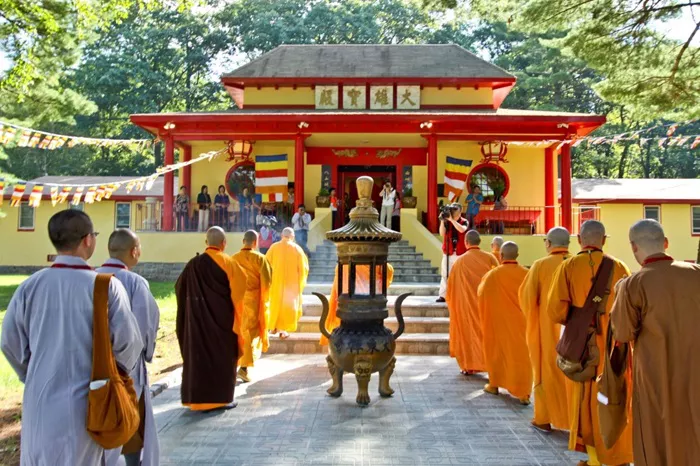Mahayana is one of the main branches of Buddhism. It is widely practiced in many countries. The word “Mahayana” means “Great Vehicle.” It focuses on compassion and wisdom. Mahayana teaches that everyone can achieve enlightenment. It encourages followers to help others reach this goal.
Many religions and cultures celebrate Mahayana. It is an important part of Buddhist traditions in East Asia and beyond. This article will explain which religions follow Mahayana, where it is practiced, and its key beliefs.
What Is Mahayana Buddhism?
Mahayana is a major school of Buddhism. It began in India around the 1st century CE. Over time, it spread to China, Japan, Korea, Vietnam, and other regions. It is different from Theravāda Buddhism, which is more common in South and Southeast Asia.
Mahayana Buddhism teaches that all beings can become Buddhas. It emphasizes the role of bodhisattvas—compassionate beings who help others achieve enlightenment. Some of the most well-known bodhisattvas include Avalokiteshvara, Manjushri, and Ksitigarbha.
Mahayana also introduced many important texts, such as the Lotus Sutra, the Heart Sutra, and the Pure Land Sutras. These scriptures guide Mahayana followers in their spiritual journey.
Which Religions Celebrate Mahayana?
1. Mahayana Buddhism
Mahayana Buddhism itself is the main religion that celebrates Mahayana. It is the dominant form of Buddhism in several countries. Mahayana Buddhists observe many festivals, such as:
Bodhi Day (December 8): Celebrates the Buddha’s enlightenment.
Vesak (Varies by country): Honors the birth, enlightenment, and passing of the Buddha.
Ullambana (Ghost Festival): A day to help the spirits of the deceased.
Avalokiteshvara’s Birthday: A festival to honor the Bodhisattva of Compassion.
Mahayana Buddhists believe in many Buddhas and bodhisattvas. They practice chanting, meditation, and making offerings at temples.
2. Vajrayana Buddhism
Vajrayana Buddhism is a branch of Mahayana. It is mainly practiced in Tibet, Bhutan, and Mongolia. Some Vajrayana traditions also exist in Nepal and parts of India. Vajrayana means “Diamond Vehicle.” It includes advanced meditation techniques and rituals.
Vajrayana celebrates many Mahayana traditions. It also has its own unique ceremonies. For example, Tibetan Buddhists honor Padmasambhava, the founder of Tibetan Buddhism. They also follow the teachings of Mahayana sutras.
3. Chinese Folk Religion
In China, Mahayana Buddhism blends with Taoism and Confucianism. Many Chinese people practice a mix of these beliefs. They visit Mahayana temples, light incense, and pray to bodhisattvas for protection and guidance.
During festivals like the Lunar New Year, people make offerings to Buddhist deities. The Ghost Festival is also influenced by Mahayana beliefs. It is a time to help spirits find peace.
4. Shingon and Tendai Buddhism in Japan
Japan has several Buddhist traditions. Shingon and Tendai Buddhism are both Mahayana schools. They follow the teachings of the Lotus Sutra and other Mahayana texts.
Shingon Buddhism includes esoteric rituals and mantras. Tendai Buddhism teaches that all beings have Buddha-nature. These traditions celebrate many Mahayana festivals.
Where Is Mahayana Buddhism Practiced?
Mahayana Buddhism is practiced in many countries. Some of the main ones include:
China: The largest Mahayana Buddhist population. Many Chinese temples follow Mahayana traditions.
Japan: Home to Zen, Pure Land, and Shingon Buddhism.
Korea: Follows Seon Buddhism, a form of Zen.
Vietnam: A mix of Mahayana and folk traditions.
Tibet and Mongolia: Vajrayana Buddhism, which comes from Mahayana.
Nepal: Both Mahayana and Vajrayana are common.
Each country has unique ways of practicing Mahayana, but they share the same core beliefs.
Key Beliefs of Mahayana Buddhism
1. Bodhisattva Path
A bodhisattva is someone who seeks enlightenment but stays to help others. They are different from arhats in Theravāda Buddhism, who seek personal liberation.
2. Buddha-Nature
Mahayana teaches that all beings have Buddha-nature. This means everyone has the potential to become enlightened.
3. Many Buddhas and Bodhisattvas
Mahayana recognizes many Buddhas. The most famous ones include:
Amitabha Buddha: The Buddha of the Pure Land.
Vairocana Buddha: A cosmic Buddha representing wisdom.
Medicine Buddha: Brings healing and well-being.
Bodhisattvas, like Avalokiteshvara and Ksitigarbha, also play an important role in Mahayana.
4. Compassion and Wisdom
Mahayana emphasizes compassion (karuṇā) and wisdom (prajñā). Followers practice kindness, generosity, and meditation to develop these qualities.
How Do People Celebrate Mahayana?
People celebrate Mahayana in many ways. Some common practices include:
Chanting sutras: Reciting Buddhist scriptures.
Meditation: Focusing the mind to achieve wisdom.
Making offerings: Giving food, flowers, and incense at temples.
Acts of compassion: Helping others and practicing kindness.
During festivals, Mahayana followers visit temples, make merit, and pray for good fortune.
Conclusion
Mahayana is an important branch of Buddhism. It is practiced in many countries and influences other religions. Mahayana Buddhism itself is the main tradition that celebrates Mahayana. Vajrayana Buddhism, Chinese folk religion, and Japanese Buddhist schools also follow Mahayana teachings.
Mahayana emphasizes compassion, wisdom, and the bodhisattva path. It teaches that all beings can become Buddhas. Festivals, chanting, and meditation are common ways people celebrate Mahayana.
By understanding Mahayana, we can appreciate its deep spiritual values. Whether through prayer, study, or acts of kindness, Mahayana continues to inspire millions of people worldwide.

